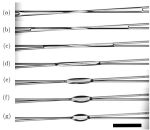EPJ E Highlight - Improving insulation materials, down to wetting crossed fibres
- Details
- Published on 30 November -0001

Scientists model the manner in which a liquid wets fibres, gaining useful insights for improving glass wool properties
Sandcastles are a prime example of how adding a small amount of liquid to a granular material changes its characteristics. But understanding the effect of a liquid wetting randomly oriented fibres in a fibrous medium remains a mystery. Relevant to the building industry, which uses glass wool, for instance, this phenomenon can be better understood by studying the behaviour of a liquid trapped between two parallel fibres. It can either remain in the shape of a drop or spread between the fibres into a long and thin column of liquid. Now, scientists have demonstrated that the spreading of the liquid is controlled by three key parameters: the amount of liquid on the fibres, the fibres’ orientation and the minimum distance between them. These findings, based on experimental and modelling work, were recently published in EPJ E. The authors are Alban Sauret, a scientist working at a laboratory jointly operated by the CNRS and Saint-Gobain, a building materials manufacturer in France, and international colleagues based at Princeton University and the NYU School of Engineering, USA.
Instead of using glass wool or fabric fibres, the authors decided to study a scaled-up version, relying on nylon fishing wire. They applied a small volume of liquid to observe how it spreads alongside the wire, crossing at various controlled angles. By taking pictures, they were able to discriminate between the different morphologies of the liquid. They then proceeded to model their observations, including various morphologies of the liquid forming either a drop, a column or a drop coexisting with a liquid column, allowing them to identify key parameters of the system.
Understanding how liquid wets glass wool could help produce cheaper materials with better properties. Indeed, optimising the number and the shape of bonds between fibres would improve the integrity of the material, and yield higher building insulation efficiency. But this could also have implications in health care products that involve other fibrous materials such as hair.
Wetting morphologies on randomly oriented fibers. A. Sauret, F. Boulogne, B. Soh, E. Dressaire, and H. A. Stone (2015), Eur. Phys. J. E 38: 62, DOI 10.1140/epje/i2015-15062-y




